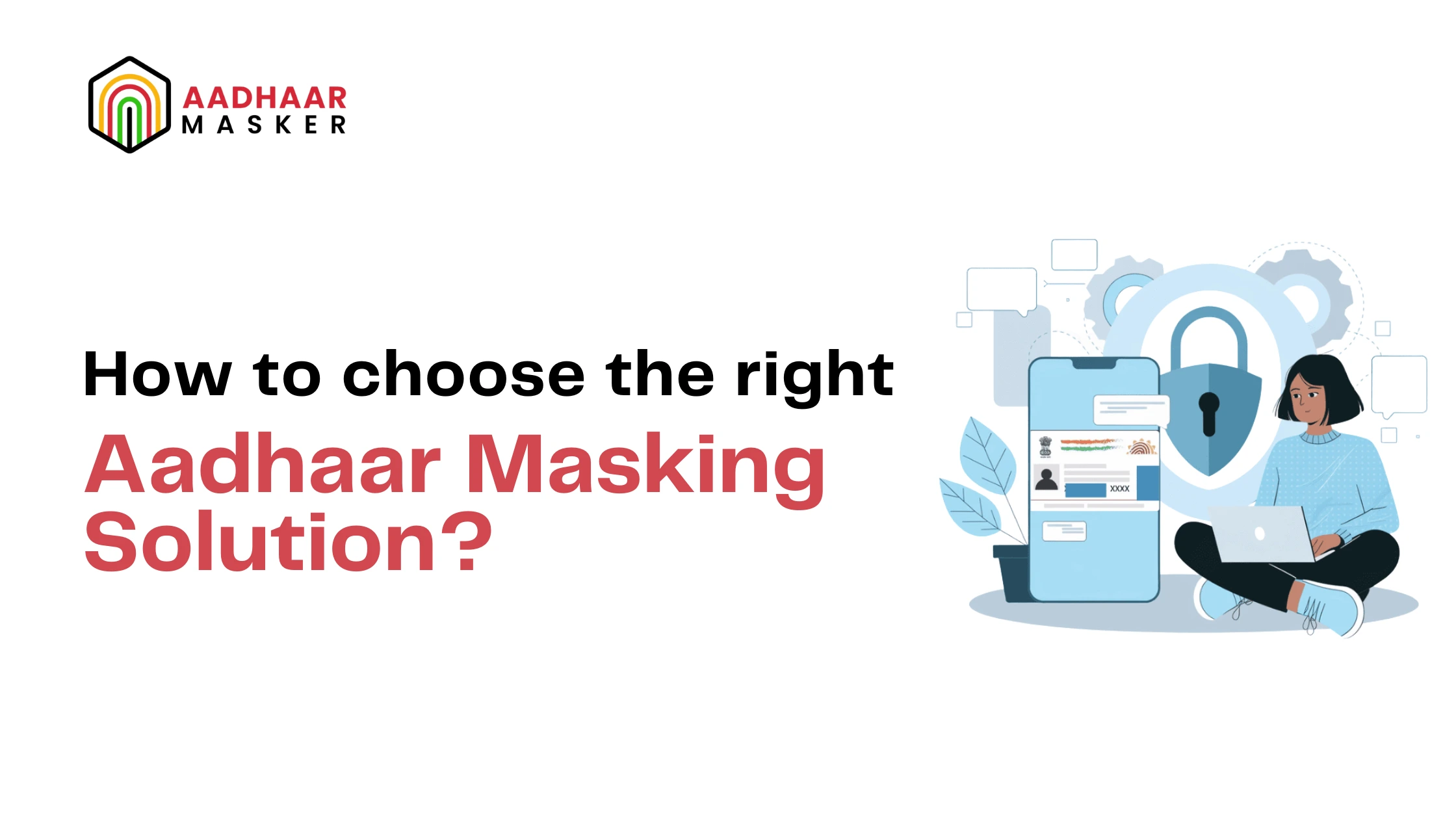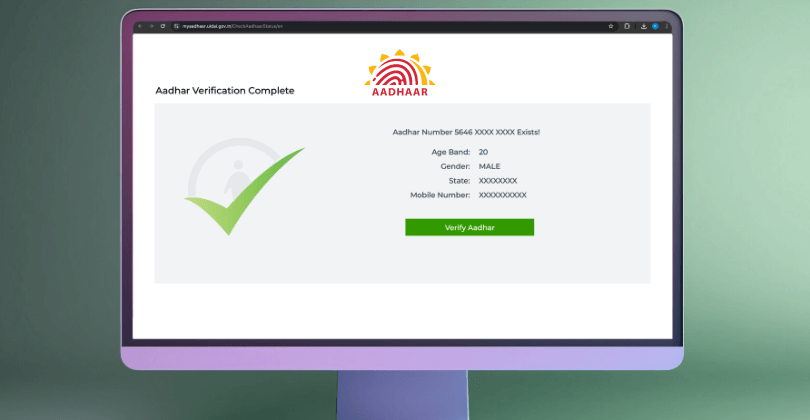How to Choose the Right Aadhaar Masking Solution?

Aadhaar masking ensures that only the last four digits of an Aadhaar number are visible, hiding the rest to prevent misuse or identity theft. For organizations handling customer data whether in banking, telecom, fintech, or hospitality choosing the right Aadhaar masking solution is not just about convenience; it’s about maintaining compliance, trust, and long term credibility.
In this guide, we will help you understand what to look for in an Aadhaar masking solution and provide a practical framework to choose the right one for your business.
Why is Aadhaar Masking Necessary?
Aadhaar masking has become a critical requirement for businesses and organizations handling sensitive identity information in India. With over a billion Aadhaar numbers issued, the potential for misuse, identity theft, and unauthorized access is significant. Masking the first eight digits of an Aadhaar number ensures that personal information remains protected while still allowing verification using the last four digits.
Several factors make Aadhaar masking necessary:
Protecting Personal Data:Full exposure of Aadhaar numbers can lead to identity theft, fraud, and misuse of confidential information. Masking reduces the risk of sensitive data falling into the wrong hands.
Regulatory Compliance: Agencies like UIDAI, RBI, IRDAI, and SEBI mandate the masking of Aadhaar numbers in customer facing processes. Non-compliance can lead to fines, penalties, or legal complications.
Maintaining Customer Trust:Customers are more likely to engage with organizations that prioritize data privacy. Masking Aadhaar numbers demonstrates a company’s commitment to protecting personal information.
Secure Digital Transactions:In sectors such as banking, fintech, telecom, and healthcare, Aadhaar masking ensures secure KYC, e-KYC, and digital onboarding processes without compromising sensitive identity data.
Minimizing Data Breach Impact: In the event of a breach, masked Aadhaar numbers reduce the severity of exposure, as attackers cannot access the full identity information.
In short, Aadhaar masking is not just a technical feature it is a privacy imperative, a regulatory requirement, and a trust-building measure that safeguards both businesses and individuals in today’s digital ecosystem.
Key Criteria for Evaluating Aadhaar Masking Solutions
Selecting the right Aadhaar masking solution requires more than just a quick comparison of features it demands a careful evaluation of security, compliance, usability, and scalability sinceaadhaar masking have many usecases. Here are the essential criteria every organization should consider before making a decision:
Robust Security Features
The core purpose of Aadhaar masking is to protect sensitive information. Look for solutions that use AI-powered OCR technology, end-to-end encryption, and secure data handling protocols. The solution should ensure that no unmasked data is stored or retrievable after processing.
Robust Security Features
Any solution you choose must fully comply with UIDAI guidelines, RBI regulations, and Data Protection Bill requirements. Non compliance can lead to severe penalties and loss of customer trust. Choose a masking solution that’s compliance-first by design, with audit-ready features and regular policy updates.
Ease of Integration and Use
The ideal masking solution should integrate effortlessly with your existing KYC, e-KYC, or document verification workflows. API or SDK based solutions offer flexibility for enterprises to deploy masking seamlessly without altering their current systems.
Scalability and Performance
Businesses dealing with high volumes of Aadhaar data such as banks, NBFCs, and telecom firms need solutions that can handle bulk masking at high speed without compromising accuracy. Scalable cloud infrastructure ensures consistent performance even during peak loads.
Customizability and Support
Every organization’s data flow is unique. A good Aadhaar masking solution should offer custom configurations, multilingual support, and adaptable workflows to suit various operational needs. Additionally, reliable technical support ensures smooth deployment and maintenance.
Step-by-Step Guide to Choosing the Right Aadhaar Masking Solution
Selecting the Ideal Aadhaar masking solution involves aligning business requirements with compliance, performance, and operational efficiency. Here is a practical step by step guide to help organizations make the right choice:
Assess Your Data Privacy Needs
Start by evaluating how Aadhaar data is collected, processed, and stored within your organization. Identify the specific points where masking is required whether during onboarding, document verification, or internal data sharing. This helps you choose a solution that fits your workflow precisely.
Understand Regulatory Requirements
Review the latest UIDAI circulars, RBI guidelines, and Data Protection Bill mandates. Ensure that the masking solution you select adheres to these standards and is built to automatically update as regulations evolve.
Evaluate Core Features and Capabilities
Look for essential features such as AI-based OCR detection, automatic masking of Aadhaar numbers, real-time processing, and bulk masking support. The solution should deliver both accuracy and speed, especially if your organization handles high data volumes.
Check Integration Flexibility
A good Aadhaar masking solution should seamlessly integrate with your KYC or eKYC systems, CRM platforms, or onboarding portals. API or SDK-based solutions provide easy deployment without major infrastructural changes.
Review Security and Compliance Credentials
Request documentation on the provider’s data encryption standards, access control mechanisms, and audit trails. Ensure that no masked data is retained post-processing and that the system supports complete compliance visibility.
Test Performance and Usability
Conduct a pilot run to test the solution’s accuracy, processing speed, and user interface. Evaluate how quickly it processes large datasets and whether it fits seamlessly into your existing workflows.
Consider Scalability and Support
As your data needs grow, your solution should scale effortlessly. Choose a provider that offers enterprise-grade scalability, 24/7 support, and continuous upgrades.
Make an Informed Decision
Compare shortlisted solutions based on performance, compliance, integration, and total cost of ownership. Opt for a partner with proven expertise in digital identity verification and data masking, like Pixl.ai’s Aadhaar Masking Solution, designed with compliance-first architecture and AI accuracy.
Conclusion: Choosing the Right Aadhaar Masking Solution for Maximum Security and Compliance
By evaluating solutions based on security features, regulatory adherence, integration capabilities, scalability, and ease of use, organizations can choose a platform tailored to their unique operational needs. When implemented effectively, Aadhaar masking not only safeguards data but also streamlines workflows for KYC, e-KYC, and customer onboarding processes.
Investing in a robust Aadhaar masking solution is more than a compliance measure it is a strategic move to build digital trust, enhance data security, and future proof your business operations. Organizations seeking a reliable, scalable, and secure solution should explore advanced platforms like Pixl Aadhaar Masking, designed to meet modern data protection and regulatory needs.





